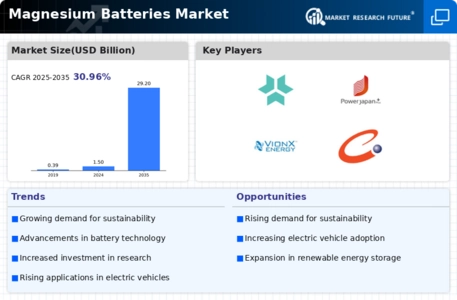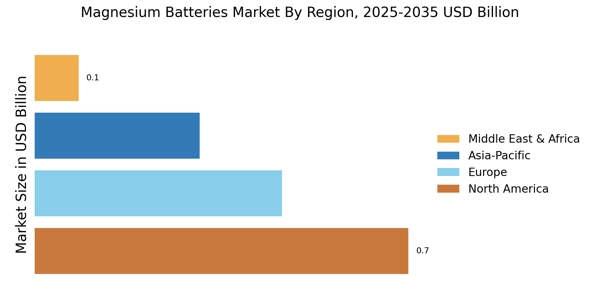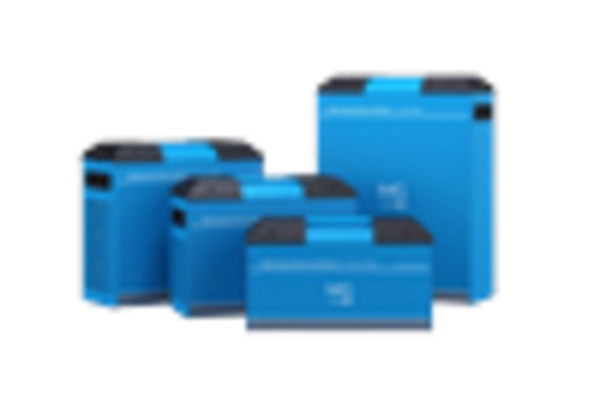Cost-Effectiveness
Cost considerations are a significant driver for the Magnesium Batteries Market. Magnesium, being more abundant and less expensive than lithium, presents a cost-effective alternative for battery production. This cost advantage is particularly appealing to manufacturers looking to reduce production expenses while maintaining performance standards. Recent analyses suggest that the production costs of magnesium batteries could be up to 30% lower than those of traditional lithium-ion batteries. As the demand for affordable energy storage solutions continues to rise, the economic viability of magnesium batteries becomes increasingly relevant. This cost-effectiveness not only attracts manufacturers but also appeals to consumers seeking budget-friendly options. The potential for lower prices could lead to wider adoption of magnesium batteries across various sectors, further driving growth within the Magnesium Batteries Market.
Regulatory Support
Regulatory frameworks are increasingly favoring the adoption of magnesium batteries, serving as a key driver for the Magnesium Batteries Market. Governments worldwide are implementing policies aimed at reducing reliance on fossil fuels and promoting cleaner energy technologies. Incentives for research and development in battery technologies, including magnesium-based solutions, are becoming more prevalent. For instance, various countries have introduced grants and subsidies to support the development of sustainable battery technologies. This regulatory support is likely to accelerate the commercialization of magnesium batteries, as manufacturers seek to align with governmental objectives. Furthermore, as regulations around battery recycling and disposal become stricter, the inherent recyclability of magnesium batteries positions them favorably in the market. This alignment with regulatory trends enhances the attractiveness of the Magnesium Batteries Market for investors and manufacturers alike.
Technological Innovations
Technological advancements play a crucial role in shaping the Magnesium Batteries Market. Ongoing research and development efforts are focused on enhancing the performance and efficiency of magnesium batteries. Innovations such as improved electrolyte formulations and advanced electrode materials are being explored to increase energy density and charge-discharge rates. For instance, recent breakthroughs have demonstrated that magnesium batteries can achieve energy densities comparable to lithium-ion batteries, which could revolutionize the market. The integration of smart technologies, such as battery management systems, further enhances the usability and safety of magnesium batteries. As these technologies mature, they are likely to attract significant investments, thereby propelling the Magnesium Batteries Market forward. The potential for high-performance applications in electric vehicles and renewable energy storage systems underscores the importance of these technological innovations.
Sustainability Initiatives
The increasing emphasis on sustainability is a pivotal driver for the Magnesium Batteries Market. As industries and consumers alike seek greener alternatives to traditional lithium-ion batteries, magnesium batteries present a compelling option due to their lower environmental impact. Magnesium is abundant and less toxic compared to lithium, making it an attractive choice for manufacturers aiming to reduce their carbon footprint. Furthermore, the recycling potential of magnesium batteries enhances their appeal, as it aligns with the circular economy principles. Recent studies indicate that the magnesium battery market could witness a compound annual growth rate of over 20% in the coming years, driven by these sustainability initiatives. This shift not only reflects a growing consumer preference for eco-friendly products but also encourages innovation within the Magnesium Batteries Market.
Diverse Application Spectrum
The versatility of magnesium batteries is a notable driver for the Magnesium Batteries Market. These batteries are being explored for a wide range of applications, including electric vehicles, portable electronics, and renewable energy storage. The growing demand for energy storage solutions, particularly in the context of renewable energy integration, positions magnesium batteries as a viable alternative. For example, the increasing adoption of solar and wind energy necessitates efficient storage systems, where magnesium batteries could play a significant role due to their favorable characteristics. Market analysts project that the demand for magnesium batteries in the automotive sector alone could reach several billion dollars by 2030, driven by the need for sustainable energy solutions. This diverse application spectrum not only broadens the market potential but also encourages further research and development within the Magnesium Batteries Market.


















Leave a Comment